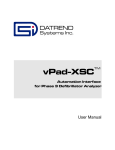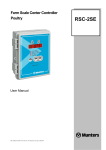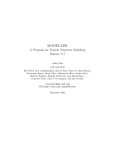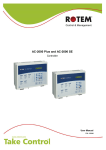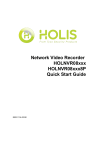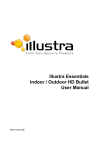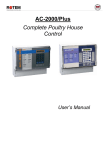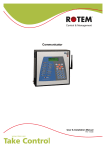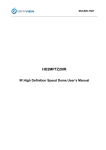Download RSC-2Poultry Scale System
Transcript
RSC-2 Poultry Scale System User Manual RSC-2 Poultry Scale System This manual is published by Rotem Computerized Controllers Ltd. All rights to this publication are reserved. No part of this document may be reproduced, transmitted, transcribed, stored in a retrieval system, or translated into any language, in any form or by any means. Rotem Computerized Controllers Ltd. reserves the right to make changes or improvements to the equipment, software, and documentation herein described at any time without notice. © Copyright 2004 by Rotem Computerized Controllers Ltd. Warning: Rotem products are designed and manufactured to provide reliable operation. Strict tests and quality control procedures are applied to every product. However, there is the possibility that something may fail beyond our control. Since these products are designed to operate climate control and other systems in confined livestock environments, where failure may cause severe damage, the user should provide adequate back up and alarm systems. These are to operate critical systems even in case of a Rotem system failure. Neglecting to provide such back up will be regarded as the user’s willingness to accept the risk of loss, injury and financial damage. Date: March 27, 2004 Software Version: 3.5 Table of Contents Warning ................................................................................................................2 Table of Contents..................................................................................................3 Introduction ...........................................................................................................4 Key Features.........................................................................................................4 Operating Principles..............................................................................................4 Control Panel ........................................................................................................5 Main Menu ............................................................................................................6 Average Weight:................................................................................................6 Number of Weights:...........................................................................................6 Daily Gain/Standard Deviation: .........................................................................6 Coefficient of Variation (C.V.)/Uniformity:..........................................................6 Growth Day: ......................................................................................................6 Advanced Functions .............................................................................................7 Weighing: ..........................................................................................................7 Weighing Questions:......................................................................................7 Print:..................................................................................................................7 Printing Questions: ........................................................................................8 History: ..............................................................................................................8 History Questions: .........................................................................................9 Scale Calibration: ............................................................................................10 Scale Calibration Questions:........................................................................10 Time Update....................................................................................................11 Parameters:.....................................................................................................11 Parameter Questions: ..................................................................................11 Parameter Table ..........................................................................................12 Parameter Definitions: .................................................................................13 Weight Correction Factor.................................................................................14 Technical Reference ...........................................................................................15 Standard Deviation..........................................................................................15 Coefficient of Variation. ...................................................................................16 Uniformity (Homogeneity or Evenness)...........................................................16 Wiring Diagram................................................................................................17 3 RSC-2 Poultry Scale System Introduction Rotem’s RSC-2 Poultry Scale weighs chickens and turkeys automatically using one or two platforms. The RSC-2 weighs the birds automatically as they mount the platform within their living area. Key Features ¾ ¾ ¾ ¾ ¾ ¾ ¾ ¾ ¾ ¾ ¾ ¾ Weighing Range According to the Installed Platform Precision per Weighing — ± 0.2% Up to Two Platforms Up to one year Data Collection Up to 100 Meter (300 feet) Cable Minimum Weighing Time — 2 to3 Seconds Battery Backup Automatic Update of Average Standard Deviation, Daily Gain, CV, Uniformity Remote Communications is Standard. Weight Histograms are available with Communications Direct Printout to a Serial Printer. Operating Principles ¾ A simple menu and three user friendly keys provide user access. ¾ Two indicator lights identify the active platform. ¾ The RSC-2 senses the change in weight when birds mount and dismount the platform. Changes within the acceptable range register as valid bird weights. ¾ Accumulations of debris tare out automatically since they are not in the range of acceptable bird weights. ¾ Multiple birds automatically register correctly as long as there is small interval between them as they mount. ¾ The RSC-2 automatically follows the birds as they grow, and updates its reference data regularly. Control Panel Scale Selection Indicators Five Digit Display with Lb and Kg Indicators Five Line menu with Indicator Lights Three Keypads to Select Menu Items and Make Changes 1. Scale Indicator Lights: Identify the current platform. Values in the display pertain to this platform. 2. Display: shows the current value. In some cases it shows an abbreviation describing the current value alternately with the value. To the right of the display are Lb (pound) and Kg (kilogram) indicators. 3. Menu: The first menu item is Average Weight. When the indicator by this item is lit, the display shows the average weight for the indicated scale platform. 4. Keypads: The ‘Select’ keypad moves from item to item in the Menu. After you reach Growth Day it moves back to Average Weight. a) Warning: You can edit the Growth Day with the Arrow keys. If you set to growth day zero, the display flashes CLEAr; if you press the Select key at this point, the RSC-2 resets to growth day 1 and erases data it has collected. If you change growth days, new data mixes with previously saved data. 5. Advanced Functions: The keypads also have advanced functions, which this manual explains later. 5 RSC-2 Poultry Scale System Main Menu Average Weight: The average weight shown is the average of birds weighed since midnight, then the last 50 birds until 200 birds have been weighed, finally the last 100 birds if 201 or more birds have been weighed. The average weight in the display pertains to the indicated weighing platform. Whenever the RSC-2 acquires a new bird weight, it flashes this weight several times before continuing to show the average weight. A flashing display indicates the latest bird’s weight; a steady display indicates an average weight. Number of Weights: This shows the number of birds weighed on the indicated weighing platform. Daily Gain/Standard Deviation: By default, this shows the weight gained since yesterday in percent. Press the Up Arrow for the standard deviation (SD) of the average weight, Down Arrow to show daily gain. Standard Deviation is a scientific measure of how even the bird weights are. Coefficient of Variation (C.V.)/Uniformity: Coefficient of Variation (CV) is another scientific measure of how even the bird weights are. It is related to Standard Deviation. Uniformity is the usual way evenness of bird weights is measured. Press the Up Arrow for Uniformity and the Down Arrow for Coefficient of Variation. Growth Day: The Growth Day is the age of the birds for the indicated platform. You can have different growth days for each weighing platform. You can adjust the growth day with the arrow keys to a maximum of 500. If you set it to zero, the display flashes CLEAr and 0. If you press the Select key at this point, the RSC-2 asks for confirmation by flashing SurE and no. Press the up arrow key to display the YES choice and clear out all history data. This resets the growth day to 1 for starting a new flock. If you change the growth day without clearing previous history, old history mixes with new data. To prevent corrupting your data while reviewing history you should use the History function, not simply move the growth day back. If you immediately change the growth day after clearing history, the RSC-2 automatically adjusts the reference weight to a typical broiler weight of that age. If your birds weigh differently, adjust the reference weight manually to approximately the weight of your birds in order to start collecting bird weights. Advanced Functions Weighing: When weighing birds, the RSC-2 takes into consideration factors to prevent weighing things that are not birds. This can make it difficult to test the scale, since a ‘correct’ bird may not be readily available. If you Press and Hold the Select key for 2 or 3 seconds, the RSC-2 switches into weighing mode, and indicates this by showing SCALE in the display for several seconds. To correctly use this feature, be sure to keep the scale empty during this time, since the RSC-2 will automatically be calculating tare and calibrating to zero. After the zero weight appears in the display, you can weigh objects just as you would on a typical bathroom or grocery scale. To return to bird weighing mode, press the Select key briefly. Here are the steps in order: 1. Keep the scale empty and steady. Start with the usual average weight in the display. 2. If you have more than one weighing platform, wait until the Scale Indicator lights for the scale platform you wish to use. 3. Press and Hold the Select Key until SCALE appears in the display. Then release the key. 4. Wait until the display returns to zero, all the while keeping the scale weighing platform empty and steady. 5. Weigh objects as desired by placing them on the platform. Their weight appears in the display. 6. To return to normal operation, briefly press the Select key. ESC will appear momentarily in the display. Weighing Questions: 1. Will the other weighing platform continue to weigh birds while this platform is in special weighing mode? a. No. 2. How heavy an object can I weigh? a. This depends on the particular weighing platform. The small stainless steel chicken platform can weigh up to 50 lb (25 kg); the larger stainless steel turkey platform can weigh up to 100 lb (50 kg). Review the specifications for the hanging platforms. 3. How accurate are the scales? a. All scale platforms have 0.2% basic accuracy. 4. Can I calibrate the scales? a. Yes. Each platform must be individually calibrated prior to use using the calibration procedure described later in this manual. Print: The RSC-2 can print its data directly to a serial printer. The printer must be suitably connected directly to the RSC-2, or indirectly through a Rotem Multiplexer or Communicator. This connection is best performed by a qualified technician. 1. To connect directly, move the DIR/MUX jumpers to the DIR position. 7 RSC-2 Poultry Scale System 2. 3. 4. 5. 6. a. The Jumpers are located directly above the green communication connector inside the RSC-2. b. Connect a serial printer to the COM, RX and TX terminals. Turn it on and set it to 9600 baud, N, 8, 1. To print indirectly through a Multiplexer or Communicator, place the jumpers in the MUX position. Connect the printer to the Multiplexer or Communicator. To start printing, Press and Hold the Down Arrow key. –Prn- displays momentarily followed by F-dAy alternating with 1. This indicates First Day to Print is day 1. If you wish, adjust the first printing day (indicated by F-dAy) with the arrow keys. Printing will start with data from this day continuing until the current growth day. a. You can not adjust the first printing day past the current growth day. Press the Select key to start printing. While printing, -Prn- flashes in the display. When finished, the flashing -Prn- disappears. Printing Questions: 1. I started a long printout, but have changed my mind. How do I stop it? a. Turn power off to the RSC-2. 2. Why does the display show F-dAy instead of F-DAY for first day? a. The display is a bright red five digit seven segment display suited to showing numbers, such as average weight. This is as close as it can come to showing letters. An uppercase D would look like a zero. However, the word displays are remarkably clear and easy to understand. 3. What is 9600, N, 8, 1? a. These have to do with RS-232 communication settings as defined by international standards. A qualified technician will understand them, as well as further questions, such as: What is RS-232? History: Use the History function to review data from previous growth days. You can review all data (Average Weight, Uniformity, etc.) for each growth day in the past without affecting scale operation. 1. Press and Hold the Up Arrow Key until –HIS- appears in the display briefly. Be sure to observe the momentary –HIS- indication, since the display will return to the average weight for today without any other indication. 2. Use the Select, Up and Down arrow keys as you would during normal operation to review data. For example, a. To review data on day 10, move to the Growth Day main menu using the Select key. Then adjust the growth day using the arrow keys. b. Press Select to choose a particular item, such as Uniformity. c. To review historical data for a different growth day, move to the growth day item again with the Select key and repeat steps a’ and b’. 3. To exit history mode, press and hold the Select key until –Esc- appears briefly in the display. History Questions: 1. Does the RSC-2 continue to weigh birds while in History Mode? a. Yes, it continues to operate normally in the background. 2. How can I tell that the RSC-2 is in History mode? a. The RSC-2 briefly displays –HIS- when it switches into history mode. b. The display stops flashing new weights as they are acquired. You can see whether new weights are being acquired by watching the Number of Weights for the current growth day. i. Note: In normal operation, the RSC-2 briefly flashes each new bird weight before continuing to display the average weight. c. You can not go to Growth Day zero. d. You can not go past the current Growth Day. e. When you press and hold Select again, it will show –ESCinstead of SCALE. However: i. If you were in history mode, you will exit it. ii. If you were not in history mode, you will enter SCALE mode. Press Select again in this case to return to normal operation. 3. What is the best way to tell the RSC-2 is in History mode? a. Carefully watch for the brief –HIS- display when the RSC-2 switches into history mode. 4. How can I view Histograms? a. You can view Histograms only at a personal computer using Rotem’s NetVision software. The software provides other important features as well. 9 RSC-2 Poultry Scale System Scale Calibration: Upon installation, each weighing platform should be calibrated. Allow a minimum 10 minute warm up time after turning on power, prior to calibrating the platform. 1. Obtain a precision weight of about 5 to 10 pounds (2 to 5 kilograms). The minimum calibration weight is 1 pound (500 grams). a. A low cost precision weight may be easily obtained at most grocery stores. Purchase a suitable beverage (such as a 2 liter soft drink, gallon of milk), and weigh it on the government certified scales at the checkout. Most cashiers will gladly sell and weigh a precision weight for you. 2. Keep the platform empty of birds and steady during the calibration process. 3. Press and Hold Simultaneously the Select and Down Arrow keys when the scale indicator for the appropriate platform is lit. a. If you are adding a second platform, or the desired scale indicator light never lights, refer to the Parameters section below. You will need to enter a calibration number initially to make the RSC-2 recognize the platform and start switching between the two. This number need not be accurate. 4. CAL-1 or CAL-2 appears in the display, depending on which platform you are calibrating. Release the Select and Down Arrow keys. 5. Press the Select key. The display starts flashing CAL-1 or CAL-2. During this period the RSC-2 is calculating the tare, so it is particularly important not to disturb the platform in any way during this period. 6. The display shows 1.00 and the appropriate scale indicator light flashes. Place the precision weight on the platform, and adjust the value in the display using the arrow keys until it registers the correct weight. 7. Press the Select key. The display will start flashing the weight you entered. During this period it is calibrating to your precision weight, so it is particularly important not to disturb the platform in any way. 8. After several seconds, the display shows Good. 9. Press the Select key to return to normal operation. Scale Calibration Questions: 1. Do I need to clean the weighing platform prior to calibration? a. No. The calibration procedure uses the same ‘change in weight’ principle that is used during normal bird weighing. As long as you do not change the amount of debris on the platform, its presence will not affect calibration. 2. Will the other platform continue to operate normally while I calibrate this one? a. No. During calibration all normal weighing operations stop. 3. I want to calibrate Scale 2, but only the Scale 1 indicator light is on. a. This is normal. By factory default, the RSC-2 uses scale platform 1 only. To start using scale platform 2, you need to signal the RSC-2 that it has another platform by entering a ‘calibration number’ other than 0 in the Calibration Parameter. See the Parameters section below. 4. How often should I calibrate the scales? a. Rotem recommends calibration once a year. 5. I see a calibration factor number on my scale platform. What is this? a. This is a factory calibration number for the platform. You can enter it manually into the calibration number as described in the Parameters section below for a quick approximate calibration. Time Update The RSC-2 has an internal battery backed clock. You can use this to schedule bird weighing for particular hours of the day in the Parameters section. To set the clock: 1. Press and Hold Simultaneously the Select and Up Arrow keys until the time appears in the display in hr.mm format. 2. The hour will be flashing. To adjust it, use the Up and Down Arrow keys. a. Note that the hour is in 24 hour military format. For example, 5:00 PM will show as 17.00. 3. When finished adjusting the hour, press the Select key. The minutes will start flashing. 4. Adjust the minutes using the arrow keys. You can press and hold an arrow key to move more quickly. 5. Press the Select key. The display briefly shows –ESC- and returns to normal operation. Parameters: The RSC-2 has many parameters with which you can customize it for your needs. While viewing the parameters, each parameter will display its value alternately with a brief acronym to identify the parameter. You can adjust the parameter with the arrow keys. This is the procedure: 1. Press and Hold Simultaneously both arrow keys until the first parameter, rEF-1, flashes in the display alternately with its value. 2. To adjust the parameter, use the up and down arrow keys. 3. When finished adjusting the parameter, press the Select key to move to the next parameter. 4. If you are finished adjusting all parameters of interest, continue pressing the Select key until you get past the last one. The RSC-2 will display –ESC- briefly after the last parameter and return to normal operation. Parameter Questions: 1. I accidentally went past the parameter I wanted. How do I back up? a. You can not back up. If you missed the parameter, you need to go through all the parameters until the –ESC- and start again. 2. I accidentally forgot to exit from Parameter mode after adjusting a parameter. I left the farm and am now at home. Must I go back to the RSC-2 and exit parameter mode? 11 RSC-2 Poultry Scale System a. Actually the RSC-2 will wait patiently for a little while and then exit by itself. There is no need to go back to the RSC-2 to exit in this case. Parameter Table Param rEF-1 rEF-2 CAL-1 CAL-2 UnIt PrC.Lo PrC.HI A.d Parameter Meaning Scale 1 Reference Weight Scale 2 Reference Weight Calibration Number, Scale 1 Calibration Number, Scale 2 Weight Unit, 0→ Kg, 1 → Lb Low Acceptance Range, % High Acceptance Range, % Stability factor for registering tare value bAud Communication Baud Rate Pc.1 Bird Scale 1 Identification Number for Communication Pc.2 Bird Scale 2 Identification Number for Communication PASS Password StArt Weighing Start Hour End Weighing End Hour tArg1 Platform 1 Target Curve Selector tArg2 Platform 2 Target Curve Selector PrC.Sn Maximum Weight Sample Deviation (per cent) Accur Minimum Number of Stable Weight Samples unF.Pr Uniformity Minimum 0 0 0 0 0 10 10 8 Default 0.048 0.048 1367 0 0 30 30 15 Maximum Custom 30 Kg 30 Kg 10000 10000 1 45 45 100 1200 0 9600 0 9600 255 0 0 255 0 0 0 0 0 0 24 0 9999 24 24 255 0 0 255 1 3 10 5 5 20 5 10 20 Parameter Definitions: 1. rEF-1: Scale 1 Reference Weight. The RSC-2 accepts bird weights that are within a limited range of the reference weight, typically ±30%. For example, if the current reference weight is 1.00 pounds, then by default weights greater than 0.70 and less than 1.30 pounds are accepted as valid : a. After CLEAR, start with reference weight of 0.100 pounds (0.048 kilograms). You can manually edit the reference weight if needed. b. If the reference weight was manually entered, retain it until midnight. c. After a new day, the reference tracks the current average weight after weighing: i. More birds than yesterday, or ii. 50 birds which ever occurs first. 2. rEF-2: Scale 2 Reference Weight. Same as rEF-1, except it applies to weighing platform 2. 3. CAL-1: Scale platform 1 calibration factor. 4. CAL-2: Scale platform 2 calibration factor. 5. UnIt: Pounds or Kilograms 6. PrC.Lo: Low acceptance limit. Birds more than this percent below the reference weight are rejected. 7. PrC.Hi: High acceptance limit. Birds more than this percent above the reference weight are rejected. 8. A.d: Stability value for establishing a new tare value. This is the minimum change in weight (in machine analog to digital converter counts) that occurs to establish a new base reading before accepting another bird weight. 9. bAud: Communication connection speed, typically 9600. 10. Pc.1: Scale number of Scale 1 for personal computer communications. Each scale platform in a network of RSC2 scale systems must have its own number. 11. Pc.2: Scale number of Scale 2 for personal computer communications. 12. PASS: Password for access via communications. 13. StArt: Start time for weighing. You can limit weighing to a start hour. 14. End: End time for weighing. You can force the RSC-2 to stop weighing at a particular hour. 15. tArg1: Reference growth curve identifier for scale weighing platform 1. The remote communications shows the particular reference curve chosen with the actual weight data when graphed on the personal computer. 16. tArg2: Reference growth curve identifier for scale weighing platform 2. 17. PrC.Sn: Each bird weight is the average of several samples (see parameter 20, Accur). Maximum sample to sample variation as a percent, for the samples to be acceptable. 18. Accur: Sets the minimum number of acceptable samples to establish a birds weight. 19. unF.Pr: Uniformity limit in percent. Default uniformity limit is plus or minus 10% of the average. 13 RSC-2 Poultry Scale System Weight Correction Factor The RSC-2 incorporates a weight correction factor curve. In certain cases, bird behavior may cause a bias in the bird weights accumulated. For example, it is possible that birds will establish a pecking order, with larger birds dominating smaller ones. In this case it may be that some smaller birds discover mounting the weighing platform gives them additional apparent size, and they move up the pecking order when on a platform. For this reason, they tend to mount the platform more frequently than the larger birds, which affects the statistical average. In most cases, these biases become consistent from flock to flock. You can add a correction curve based on bird age to account for this variation. To enter the correction curve menu, simultaneously press and hold all three keys until ‘1’ alternates with the correction factor for day 1, by default 1.00. Edit the value for day 1, if desired using the arrow keys. Press the Select key briefly to move to the next day and back to day 1 again if desired. To exit the correction factor menu, press and hold the Select key until –ESC- appears in the display. You can not the programmed growth days, only the factor for these days. Factory default correction curve: Day 1 10 20 30 40 50 60 Factor 1.00 1.00 1.00 1.00 1.00 1.00 1.00 Technical Reference Standard Deviation The standard deviation is kind of the "mean of the mean," and often can help you find the story behind the data. A normal distribution of data means that most of the weights in a set of data are close to the "average," while relatively few examples tend to one extreme or the other. If you looked at normally distributed data on a graph, it would look something like this: The x-axis is the weight. And the y-axis (the vertical one) is the number of weights for each value on the x-axis. Standard Deviation n – Number of weights. A smaller number in standard deviation indicates a more uniform flock. 15 RSC-2 Poultry Scale System Coefficient of Variation. The CV (Percentage) is calculated by the following formula: CV = (standard deviation / Average) x 100 The CV is expresses the standard deviation as a percentage of the average weight. This term describes the variation among the recorded body weights accounting for the relative size of the birds. A 0.1 pound variation, for example, is more important for one week birds than for much larger 8 week birds. Uniformity (Homogeneity or Evenness) Counting birds with body weight within a range of either ±10% or ±15% of the average body weight gives the uniformity. The number of birds in this range is expressed as a percentage of the total number weighed. In Europe most managers use the ±10% range but the fact that different ranges are used does sometimes cause confusion. This method of describing variation is easy to practice but it does not accurately account for all variation in the way that CV does. The formula for Uniformity is: Uniformity = (number of birds within ±10% of Average / Number of weights) x 100 Environmental Protection Recycle raw materials instead of disposing as waste. The controller, accessories and packaging should be sorted for environmentalfriendly recycling. The plastic components are labeled for categorized recycling. Wiring Diagram RX TX COM Protected Side RPLP-1 Unprotected GND Neutral Phase ROTEM Computerized Controllers Ltd. 972-3-920-6200 FAX: 972-3-924-9834 ISRAEL Web site- www.rotem.com Email- [email protected] 17

















